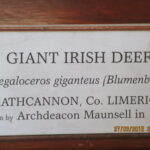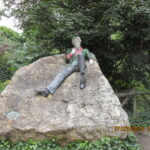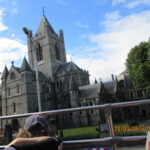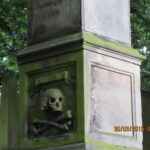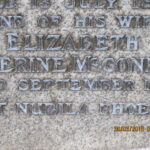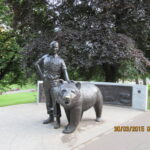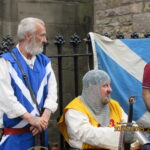Most people know that my father’s people all came from the highlands of Scotland. That is my only ‘known’ heritage, and the heritage I feel most strongly about – so I have always wanted to go to Scotland. That is the beginning of the story. William, the world traveler, spend 3 months in Africa, primarily Ghana, and was heading back to the states in late June. We decided to meet in Dublin, Ireland and travel to Scotland. As with all of the trips we have taken my job is getting there and William takes care of the internal arrangements. First let me say that there is not enough time- ever- to see and do all that you want. Second, travel light, and third, be prepared for anything!
Arrived in Dublin – lovely airport; met William who arrived from Ghana – that was great – and now we are in Ireland! We hit the Hop On-Hop Off and quickly toured the City, including a stop at the natural history museum.
Now THAT is a Moose! Above William’s head – it was a building filled with ancient animals – well, not the animal, but the bones and stuffed creatures to make sure that we know who (what) was in Ireland from early times.
We only had one day in Dublin – so touring was the best way to see a bit of it – of course that isn’t enough time to see much of anything – so I have to go back!
The next morning, we flew to London. Quick flight, and from the airport to the train station where we boarded a train for Edinburgh, Scotland. This really is a trip I have been looking forward to all of my life. It was exciting to board the train….and then the train A/C failed, and it was quite warm, and the lady next to us had a crying baby….but I was getting to see the countryside as we sweated our way through England and on to Scotland.
We arrived in Edinburgh mid afternoon – took a taxi to our Lodgings which William had arranged – an how cool is this place!! Two bedrooms, two bathrooms – a lovely apartment a couple of blocks from Edinburgh Castle. If you are traveling – have William book your lodgings!
So we unpack and explore. First stop, Edinburgh castle and town.
Edinburgh Castle is a historic fortress which dominates the skyline of the city of Edinburgh, Scotland, from its position on the Castle Rock. Archaeologists have established human occupation of the rock since at least the Iron Age, although the nature of the early settlement is unclear. There has been a royal castle on the rock since at least the reign of David I in the 12th century, and the site continued to be a royal residence until 1633. From the 15th century the castle’s residential role declined, and by the 17th century it was principally used as military barracks with a large garrison. Its importance as a part of Scotland’s national heritage was recognized increasingly from the early 19th century onwards, and various restoration programmed have been carried out over the past century and a half. As one of the most important strongholds in the Kingdom of Scotland, Edinburgh Castle was involved in many historical conflicts from the Wars of Scottish Independence in the 14th century to the Jacobite Rising of 1745. Research undertaken in 2014 identified 26 sieges in its 1100-year-old history, giving it a claim to having been “the most besieged place in Great Britain and one of the most attacked in the world”. https://www.visitscotland.com/info/see-do/edinburgh-castle-p245821

I wish I could remember all the exciting and wonderful things we did while in Scotland – we ate fish and chips (wonderful), drank wonderful beer, and Scotch – did a Scotch tasting – official tasting, I tasted a lot of Scotch independent of the official tasting….walked a lot – and explored the highlands – the scenery was awe inspiring, and I felt like I could stay forever! We saw the little café where JK Rowling wrote parts of Harry Potter, (https://en.wikipedia.org/wiki/J._K._Rowling), and we wandered through a totally ancient cemetery…
And the park below the University of Edinburgh
The up the hill to the University
Edinburgh is a beautiful and very historic city – beyond that the Scots are a very frank, and plain spoken people
I rather like the message – no holding back and no doubt about the message 🙂
We explored the castle and the town below. You just never know what you will see

The Grassmarket was also a traditional place of public executions.
A memorial near the site once occupied by the gibbet was created by public subscription in 1937. It commemorates over 100 Covenanters who died on the gallows between 1661 and 1688 during the period known as The Killing Time. Their names, where known, are recorded on a nearby plaque. One obdurate prisoner’s refusal to escape death by swearing loyalty to the Crown prompted the snide remark by the Duke of Rothes that he had chosen to “glorify God in the Grassmarket”.
In 1736 the Grassmarket formed the backdrop to the Porteous Riots which ended in the lynching of a captain of the Town Guard. A plaque near the traditional execution site now marks the spot where an enraged mob brought Captain Porteous’s life to a brutal end.
A popular story in Edinburgh is that of Margaret Dickson, a fishwife from Musselburgh who was hanged in the Grassmarket in 1724 for murdering her illegitimate baby shortly after birth. After the hanging, her body was taken back to Musselburgh on a cart. However, on the way there she awoke. Since, under Scots Law, her punishment had been carried out, she could not be executed for a second time for the same crime (only later were the words “until dead” added to the sentence of hanging). Her “resurrection” was also to some extent seen as divine intervention, and so she was allowed to go free. In later life (and legend) she was referred to as “half-hangit Maggie”. There is now a pub in the Grassmarket named after her.
In 1775, the young advocate James Boswell’s first criminal client, John Reid from Peeblesshire, was hanged in the Grassmarket for sheep-stealing. Boswell, convinced of his client’s innocence and citing Maggie Dickson’s miraculous recovery, hatched a plan to recover Reid’s corpse immediately after execution and have it resuscitated by surgeons. He was finally dissuaded from this course of action by a friend who warned him that the condemned man had become resigned to his fate and might well curse Boswell for bringing him back to life.
Sir Walter Scott described his memory of the Grassmarket gibbet in his novel The Heart of Midlothian published in 1818.
“The fatal day was announced to the public, by the appearance of a huge black gallows-tree towards the eastern end of the Grassmarket. This ill-omened apparition was of great height, with a scaffold surrounding it, and a double ladder placed against it, for the ascent of the unhappy criminal and the executioner. As this apparatus was always arranged before dawn, it seemed as if the gallows had grown out of the earth in the course of one night, like the production of some foul demon; and I well remember the fright with which the schoolboys, when I was one of their number, used to regard these ominous signs of deadly preparation. On the night after the execution the gallows again disappeared, and was conveyed in silence and darkness to the place where it was usually deposited, which was one of the vaults under the Parliament House, or courts of justice.”
We explored the city under the city – where the citizens who worked in the town lived. Far below ground, no sunlight piercing the gloom and still air, people lived, birthed, raised families, and died. When disease struck it spread rapidly through the dim place. Children ran and played in the same rivers of soil and sewage under the city. Life for the poor, the “normal” citizenry was difficult and these places help us to understand…understand disease – both physical and political.
The Museum of History of Scotland was a lovely exploration as well.
